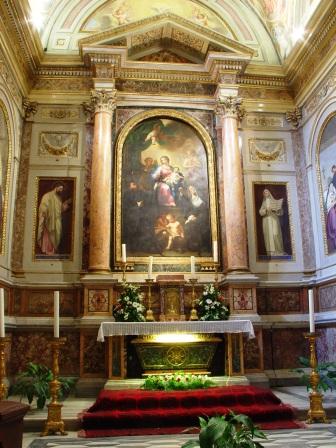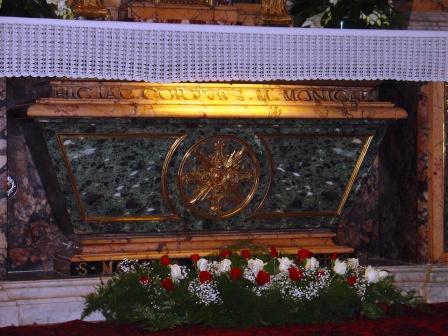This is the chapel in the church of St. Augustine in Rome (literally across the street from my back door) on the day when the bones of St. Augustine were brought from their resting place in Pavia to Rome. For the first time since 387, son and mother were reunited.
Here is a closer shot of her tomb.
How did the tomb of St. Monica wind up here? Here is an excerpt from an article I wrote for Inside the Vatican (December 2004) on the abovementioned event. I used the alternate (and more accurate Punic) spelling of the saint’s name – "Monnica" (emphasis not in the original):
Most visitors to the Eternal City find it puzzling and wondrous that Monnica’s remains would be in Rome and even more so that Augustine’s should be in northern Italy, or that we have them at all. How did this come to pass? Monnica died at age 56 of a malarial fever at Ostia, Rome’s port city, not far from where modern Rome’s port, DaVinci airport, is situated. After Augustine’s baptism in 386 by Milan’s bishop St. Ambrose (+ AD 397), Monnica and Augustine together with his brother Navigius, Adeodatus the future bishop’s son by his concubine of many years whom Monnica had forced Augustine to put aside, and friends Nebridius, Alypius and the former Imperial secret service agent (agens in rebus) Evodius were all waiting at Ostia to return home to Africa by ship. They were stuck there for some time because the port was blockaded during a period of civil strife. As she lay dying near Rome, Monnica told Augustine (conf. 9): “Lay this body anywhere, let not the care for it trouble you at all. This only I ask, that you will remember me at the Lord’s altar, wherever you be.” She was buried there in Ostia. In the 6th century she was moved to a little church named for St. Aurea, an early martyr of the city, and there she remained until 1430 when her remains were translated by Pope Martin V to the Roman Basilica of St. Augustine built in 1420 by the famous Guillaume Card. D’Estouteville of Rouen, then Camerlengo under Pope Sixtus IV. As fate or God’s directing have would have it, in December 1945, some children were digging a hole in the courtyard of the little church of St. Aurea next to the ruins of ancient Ostia. They wanted to put up a basketball hoop, probably having been taught the exciting new game – so different from soccer – by American GIs. While digging they discovered the broken marble epitaph which had marked Monnica’s ancient grave. Scholars were able to authenticate the inscription, the text of which had been preserved in a medieval manuscript. The epitaph had been composed during Augustine’s lifetime by no less then a former Consul of AD 408 and resident at Ostia, Anicius Auchenius Bassus, perhaps Augustine’s host during their sojourn. It is possible that Anicius Bassus placed the epitaph there after 410 which saw the ravages of Alaric the Visigoth and the sacking of Rome and its environs. One can almost feel behind these traces of ancient evidence Augustine’s plea to his old friend sent by letter from the port of Hippo Regius over the waves to Ostia. Hearing of the devastation to the area, far more shocking to the ancients than the events of 11 September were for us, did Augustine, now a renowned bishop, ask his old friend to tend the grave of the mother whom he had so loved and who in her time had wept for her son’s sins and rejoiced in his conversion?




































Gee, I didn’t know you were there. That’s where I’ve habitually gone to pray when I’m in Rome. Once I was in the chapel while Mass was going on, I tried to sneak up quietly to venerate her relics. When I kissed the reliquary (or the altar or something), my glasses hit metal and made the loudest “clack.” It reminded me of those scenes in old movies where two bespectacled nerds have their first kiss interrupted by the collision of metal and glass. That’s me, unspoiled by contact lenses. Are you in the Casa del Clero?
Santa Mônica, rogai por nós!
Mike: It’s good that you don’t have braces, too. Yes, I live (most of the year) in Rome.
Oh, wow. Some of my most vivid memories of Rome are from that church. Three Januaries ago, when I was with a study-trip in the city, I discovered Sant’Agostino quite by accident, but found that it was a great place to come pray. One evening, as I slipped into the church to visit the Blessed Sacrament, two vested clergymen came, took the sacrament out of the side altar’s tabernacle, and took it to the high altar. Curious, I followed and knelt in the pews (where a few people were stationed already). They exposed a host on the altar, and before I quite knew what was happening, I was chanting Vespers with a bunch of black-habited monks, sharing a breviary with the one sitting next to me! I hadn’t even noticed him when I sat down.
And this within a month of my entering the Church. Graces did abound that winter in Rome.
A question that has always bothered me: whatever became of Augustine’s concubine?? Did he provide for her? If he simply put her aside with no care being taken this seems a mark against his sanctity. I have never heard anyone comment on what happened to her – if we know.
This issue of the concubine was incredibly painful for Augustine. She completely disappears from view.
Oh, I knew you were in Rome. I didn’t know your neighborhood. Then you are at the Casa del Clero?
Father,
Tomorrow’s the big feast day, and just to let you know, I’m breathlessly waiting for your post on St. Edmund Arrowsmith!
Arrowsmith? Today? Dream on.
Mike,
“Arrowsmith? Today?”
Already. Can you believe it? ‘Tis that time of the rolling year!
I figured he would come through for you. I just couldn’t resist punning on the Aerosmith song “Dream On.” My childhood in the 1970s kicks in at the oddest times.
Just arrived back from Rome, unaware of the fact that St.Monica was buried there. Can you tell me where, exactly, Sant’Agostino is located? What landmarks is it near? I have looked everywhere on the maps that I have, and I am unable to find its location.
It is near Piazza Navona. You have to ascend stairs to get to the entrance of the Church. If I remember correctly, there is also a Caravaggio in the Church.
Is there any way to edit comments already posted?
Is there any way to edit comments already posted?
You have to be a “user” of the blog (as opposed to someone who just drops by to read and comment) to edit your comments. The blog admin also has the ability to edit any comment. The reason for this is that the blog software has no idea who “RBrown” (for example) is. Anyone could come on and say “I am ‘RBrown,’ let me edit ‘RBrown”s comments.”